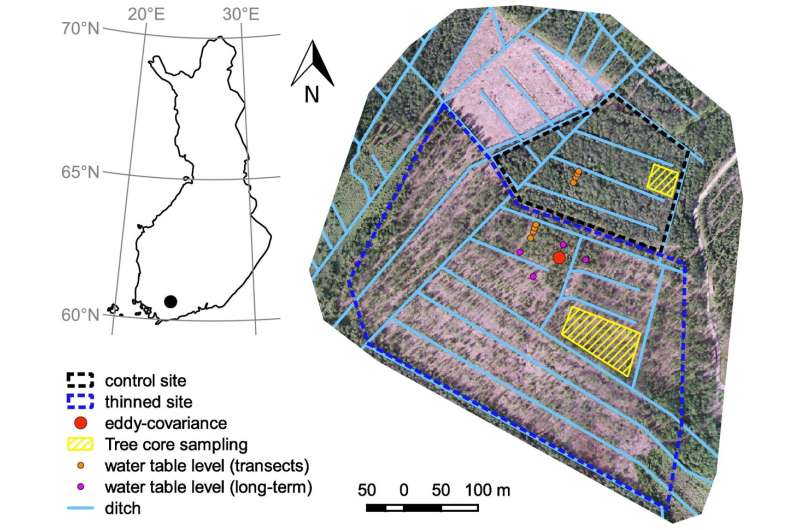This article has been reviewed according to Science X's editorial process and policies. Editors have highlighted the following attributes while ensuring the content's credibility:
fact-checked
peer-reviewed publication
proofread
Fast recovery of suppressed Norway spruce trees after selection harvesting on a drained peatland forest site

Based on a new study, the carbon sequestration of suppressed spruces recovered during the following growth season after a selection harvesting. This is great news from the perspective of climate change. The prerequisites for practicing continuous cover forestry in fertile drained peatland forests are also good from the perspective of tree growth, as the slow stem diameter growth period, sc. "release effect" proved to be relatively short.
Continuous cover forestry has been proposed as an alternative to even-aged rotation based forest management in drained peatland forests. Based on previous research, the avoidance of ditch network maintenance, mitigation of water quality and climate impacts, and better financial profitability have been considered the advantages of continuous cover forestry in spruce-dominated peatland forests.
On the other hand, continuous cover forestry has been questioned with regards to tree growth, especially as after selection harvesting the spruce trees released from their suppressed position in relation to the dominant trees tend to grow slower for several years, stunting their growth even in an otherwise suitable growth environment.
"The isotope analyses carried out indicate that the carbon dioxide sequestration of the suppressed trees accelerated immediately during the next growth season following the selection harvesting, even if the stem diameter growth recovered more slowly," says Professor Aleksi Lehtonen from the Natural Resources Institute Finland (Luke).
As a consequence of the selection harvesting, the growth space of the suppressed spruces increased a great deal, although this varied between the individual trees. Based on the study, the change in the trees' photosynthesis reflected the altered light conditions.
The results led the researchers to determine that the increased carbon sequestration of the suppressed trees was targeted elsewhere than the stem during the years after the selection harvesting, most likely at strengthening the tree's root system.
The slow growth period of the suppressed trees lasted less than five years. During the five years after the selection harvesting, the relative change of the stem diameter growth of suppressed trees was larger than that of dominating trees, when comparing the period preceding the harvesting to the period following it.
In the study, the stem diameter growth of the trees was measured both in suppressed trees and dominant trees before and after the selection harvesting. Additionally, the ratio of stable isotopes (13C/12C) was measured from the tree rings both in the selection harvesting area and an unharvested control area. This isotope ratio allows reviewing the relation of the trees' rate of photosynthesis and the stomatal conductivity, i.e., the photosynthetic rate of trees in comparison to water use. The study was implemented in Lettosuo in Tammela.
The research results were published in the Forest Ecology and Management.
More information: Aleksi Lehtonen et al, Fast recovery of suppressed Norway spruce trees after selection harvesting on a drained peatland forest site, Forest Ecology and Management (2023). DOI: 10.1016/j.foreco.2022.120759
Journal information: Forest Ecology and Management
Provided by Natural Resources Institute Finland (Luke)




















